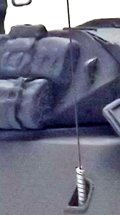GMC 6x6 2.5ton DUKW 353
Over 21000 DUKW's were built and supplied to the U.S. Army and Marine Corps. Around 2,000 were also supplied to Britain, 535 to Australia and 586 were supplied to the USSR. Although initially sent to Guadalcanal, their first operational use was in Operation Husky, the invasion of Sicily. Also in the ETO they were used on D-Day in Normandy and in the battles of the Scheldt Estuary and Operations Veritable and Plunder, the Rhine Crossings. In the Pacific, USMC DUKW's were used to cross the coral reefs of islands such as Saipan and Guam.
- SKU: US144
- Shipping info
We ship to all countries World Wide. If you receive an error message "No shipping location available" or similar, please contact us directly by e-mail (info@milicast.com) and we shall assist. Sorry for any inconvenience this may cause.
Shipments outside the UK may be subject to Duty & Taxes from the government of the destination country. Payment of Duty & Taxes are the responsibility of the customer.
- Payment methods

- Return Policy
We accept returns
The DUKW was designed by Rod Stephens, Jr. of Sparkman & Stephens, yacht designers, British deep-water sailor and US resident Dennis Puleston and Frank W. Speir from the MIT at the behest of the US War Dept., to solve the problem of resupply to units following amphibious landings. Initially rejected, one prototype was by chance involved in the rescue of seven stranded Coast Guard personnel trapped on a sand bar near Provincetown, Mass., when the experimental DUKW was on hand to lift then men off when heavy surf prevented conventional craft from approaching their vessel. All opposition by the Military ceased as a result and full production of the amphibian was given the green light. The DUKW was built around the GMC AFKWX, COE version of the standard truck, with the addition of a watertight hull and a propeller. It was powered by a GMC Model 270 straight-six engine. A five-speed overdrive transmission drove a transfer case for the propeller, then a two-speed transfer case to drive the axles. The propeller and front axle were selectable from their transfer case. A power take-off on the transmission drove an air-compressor and winch. It weighed 15,900 kg empty and operated at 50mph on roads and 5.5 knots (6mph) water. It was not an armoured vehicle, being plated only with sheet metal between 1.6 and 3.2 mm thickness to minimize the weight. A high capacity bilge pump system kept it afloat if the thin hull was breached by holes up to 51 mm in diameter. One in every four DUKWs mounted a .50-caliber Browning heavy machine gun on an M36 ring mount. Built by Yellow Truck and Coach Co., part of GMC. after 1943, at their Pontiac West Assembly Plant and at the Chevrolet Div. of General Motors Corp. at their St. Louis Truck Assembly Plant. A total of 21,147 were manufactured before production ended in 1945. Supplied to the U.S. Army and Marine Corps, 2,000 were also supplied to Britain, 535 to Australia and 586 were supplied to the USSR. They would later build their own version, the BAV 485 after the war. Although initially sent to Guadalcanal, their first operational use was in Operation Husky, the invasion of Sicily. Also in the ETO they were used on D-Day in Normandy and in the battles of the Scheldt Estuary and Operations Veritable and Plunder, the Rhine Crossings. In the Pacific, USMC DUKW's were used to cross the coral reefs of islands such as Saipan and Guam. After World War II, reduced numbers were kept in service by the United States, Britain, France, and Australia. The U.S. Army reactivated and deployed several hundred at the outbreak of the Korean War were they were used extensively to bring supplies ashore during the Battle of Pusan Perimeter and in the amphibious landings at Incheon. DUKWs were supplied to the France and were used by the Troupes de Marine and naval commandos. Many were deployed in French Indochina during the First Indochina War. Britain deployed DUKWs to Malaya during the Malayan Emergency of 1948–60. Many were redeployed to Borneo during the Indonesia–Malaysia confrontation of 1962–66.
- ManufacturerMilicast
- Unit of SaleSingle Unit
- Assembly StatusUnassembled Kit
- Scale1:76
- Age Level17 Years & Up
- Skill Level3 – Intermediate
- ThemeMilitaria
We ship to all countries World Wide. If you receive an error message "No shipping location available" or similar, please contact us directly by e-mail (info@milicast.com) and we shall assist. Sorry for any inconvenience this may cause.
Shipments outside the UK may be subject to Duty & Taxes from the government of the destination country. Payment of Duty & Taxes are the responsibility of the customer.
We accept the following payment methods:

To pay by credit or debit card, please select Stripe at checkout.
All Goods remain the property of Milicast Model Company until paid for in full. Goods may only be returned by prior arrangement at the recipients' expense. Delivery and insurance charges are non-refundable. Claims for damaged/missing items should be made within seven days of receipt.
Any products purchased 'second hand’, (without proof of direct Milicast Model Company supply, or supply from an Milicast Model Company approved dealer, shop or agent), or any products part assembled or part worked on in any way, are not covered by this returns policy. Under these circumstances no returns will be accepted, however we may quote for the supply of parts to restore the product to full inventory.





















